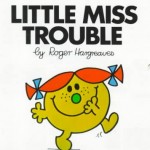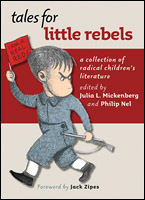 For some time now, I have been interested in thinking through the potential ethical and political value of asking “why.” Cultivating selves/communities who persistently ask “why” (along with “at whose expense”) is a central part of my own feminist ethico-political project. Recently I came across a children’s story, “Why?” from Fairy Tales for Workers’ Children (1925). I found the story in the recent (and totally awesome) edited collection of Radical Children’s Literature from Julia L. Mickenberg and Philip Nel: tales for little rebels. When I first wrote this paragraph, I incorrectly identified the book as tales from little rebels. Wouldn’t that be a cool book? Tales of resistance from little kids? Hmm…what would that look like? I’m sure that kids could have a lot to say about rebellion and resistance…and a lot that they could teach us (well, at least me).
For some time now, I have been interested in thinking through the potential ethical and political value of asking “why.” Cultivating selves/communities who persistently ask “why” (along with “at whose expense”) is a central part of my own feminist ethico-political project. Recently I came across a children’s story, “Why?” from Fairy Tales for Workers’ Children (1925). I found the story in the recent (and totally awesome) edited collection of Radical Children’s Literature from Julia L. Mickenberg and Philip Nel: tales for little rebels. When I first wrote this paragraph, I incorrectly identified the book as tales from little rebels. Wouldn’t that be a cool book? Tales of resistance from little kids? Hmm…what would that look like? I’m sure that kids could have a lot to say about rebellion and resistance…and a lot that they could teach us (well, at least me).
Since the inception of this research/writing/thinking/engaging blog back in May 2009, I have positioned my vision/version of troublemaking beside (in relation to) kids; much of my work is inspired by my desire to make sense of my own experiences as a troublemaking kid (and the experiences of my daughter whose image serves as the mascot for this blog). It is also inspired by a desire to develop methods for promoting feminst curiosity and wonder in children. I think that this edited collection for little rebels might be an excellent resource as I continue to think through my project/s.
Before moving into a discussion of the story, “Why?,” here are a few passages from the introduction of the collection that I would like to spend more time reflecting on in some future post:
On the difference between politics and morality: Children’s literature is necessarily involved in both morality (making distinctions between right and wrong) and politics (which are about the power to effect change). Teaching children to obey a higher authority may be understood as a moral lesson, but it can also be understood as a political lesson (1).
On the presence of politics in children’s literature: For those who would argue that politics have no place in children’s literature, we maintain that there is no way to keep politics out. Stories that uphold the status quo (arguably the majority of works published for children) may not seem political, but they represent efforts to teach children that the current social, political, economic, and environmental orders are as they should be (2).
What sort of literature is appropriate for children? What responsibility do adults have to children to keep them informed about critical issues of the day, such as global warming, terrorism, political corruption, and corporate greed? At what point must an ideal of “protection” end and one of preparation necessarily begin (5)?
So much that I want to discuss here in terms of how to distinguish between ethics and politics (and whether or not we even should); how to create/bear witness to stories for kids that don’t perpetuate the status quo; and how to think about the roles of protection and preparation in children’s literature (are these the only roles)?
Now, onto the story: “Why” from Fairy Tales for Worker’s Children (1925). This story is the first one in Mickenberg and Nel’s section on Imagination.
Once upon a time there lived a little boy named Paul who had no mother or father. He was very curious and liked to ask “why” all of the time. He was also very poor and never had enough food to eat. All of the people in the town were very old and very unhappy; they really didn’t like Paul always asking “why” and trying to figure out the cause of everything. The Matron would say: “You mustn’t always ask why. Everything is as it is, and therefore is right” (141).
Here’s a passage that I particularly liked: “Keep quiet, you good-for-nothing! Leave me alone with your eternal questions.” The fat woman was quite red with anger, because she knew no answer to Paul’s questions, and nothing angers ignorant persons more than to be forced to say, “I don’t know” (141).
…back to the story. One day, after asking too many questions and being slapped for it, Paul runs away.
First he runs to the chicken yard and happens upon the chickens just as they were laying eggs. Paul asks a hen, “where do all of your eggs go to?” After being told that all of the eggs go to the rich people in the city, Paul asks: “Why don’t I ever have an egg?” When the hen replies that he is a “poor Have-nothing” Paul asks, “Why am I a poor Have-nothing?” Angered by his bothersome questions, the hen shoos him away.
Second he runs to a cowshed where he happens upon the cows. He asks one of the cows for some milk. When the cow declines, explaining that the milk belongs to the farmer and that it will be sent to the city for rich people to drink, Paul ask, “Do the poor children there get any of the milk?” The cow chastises him, describing how the milk will be used for making delicious whipped cream for cakes and puddings for the rich. When Paul wonders if the poor children will get these treats too, the cow tells him to stop asking so many questions and to go away before the farmer comes and beats him.
Third he runs to a wheat field. Paul pesters the wheat about who will get to eat the bread that is made from them. When he is again told that the food is for rich people he exclaims, “Ah, again the rich people! Does everything in this world belong to the rich people?” When the ears of wheat softly buzz, “everything, everything,” Paul cries, “WHY?” They laugh at him for asking such a stupid question.
By this time Paul, who is near tears, angrily demands an answer to his questions. He is told to seek out the Owl for answers. The Owl happens to be a mean and imperious She–are Owls usually gendered as “she”? This Owl seems to represent tradition and knowledge here. Reminds me of an earlier entry I wrote about the Sour Kangaroo in Horton Hears a Who as the bearer of tradition and that which gets in the way of innovation, change and critical thinking. The only other wise Owls I can think of are the male Owls in Winnie the Pooh and the “how many licks?” commercial.
Anyway, the Owl, who doesn’t want to “waste her precious time on such a stupid child as Paul,” is too busy focusing all of her attention on a more important question, “Why are people so stupid?” She is particularly interested in examining why poor people, who work very hard, yet never seem to get anywhere, are so stupid. She is not interested in talking with Paul about his questions, and sends him away.
Totally depressed, Paul sinks down in the ground. Suddenly a fairy asks him, “why are you crying my child?” When Paul laments how lonely and sad he is because he seems to be the only person who ever wonders why, the fairy comforts him and tells him that if he listens really closely, he will hear poor people all over the world repeatedly asking why. Here are a few of her comments from page 145:
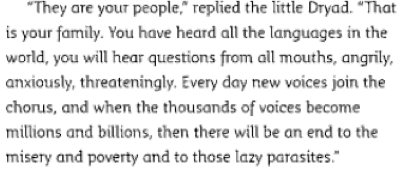
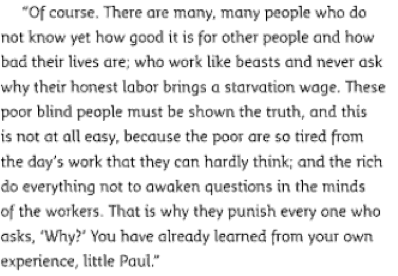
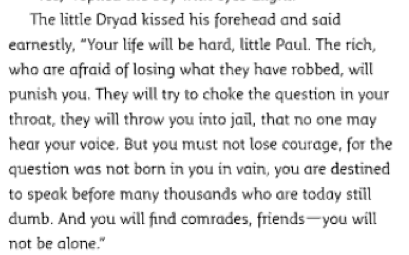
With her final statements I think the fairy is offering one answer to the question I pose in the title of this entry: Can asking “why?” lead to resistance and social transformation? Yes, potentially, with the help of consciousness-raising and collective awareness. I have a few issues with this story (singular focus on class, reliance on older woman as perpetuators of status quo–the old lady who laughs at Paul, the hen, the wise Owl), but I do appreciate the connections that it draws between curiosity, education and justice. I think I want to read this story to my kids to see what they think. Hmmm….
More links to check out:
- More entries on kids’ books from trouble
- C SPAN Program of author’s talking about/reading from book


